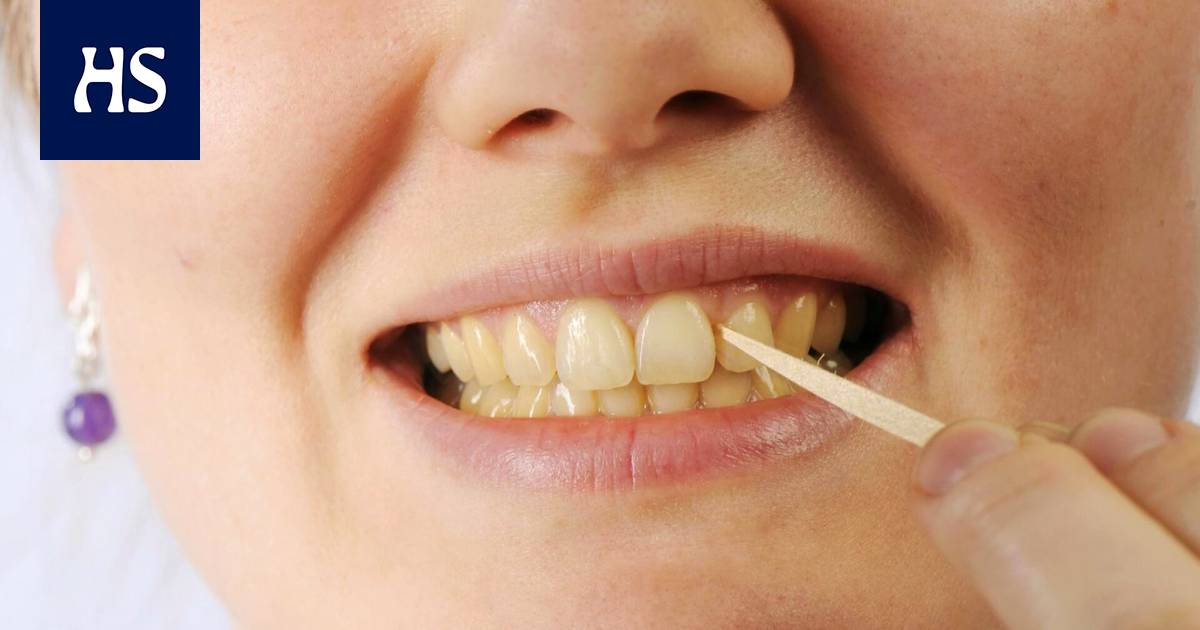When tooth enamel is lost, it cannot be restored or improved.
Almost already half of Finnish adults have dental erosion. The erosion of young teeth also seems to have increased, says the doctor of dentistry Delay Alaraudanjoki.
In erosion, i.e. tooth decay, the tooth enamel first softens and then dissolves and disappears. Frayed, sharp and translucent tips of the front teeth usually indicate erosional damage to the teeth. If scaly, yellowish spots start to appear on the teeth, the erosion is already advanced.
Alaraudanjoki works as the regional head dentist of the Ylioppilaiden health care foundation (YTHS) in Oulu and has done dental erosion dissertationpublished in 2018.
Erosion is caused by both stomach acids, i.e. reflux disease, heartburn or profuse vomiting, and acidic foods and drinks.
“Stomach acids returning to the mouth wear away the enamel the most, i.e. cause the most erosion, but at the population level, the majority of the causes are acidic drinks and food,” Alaraudanjoki says.
When tooth enamel is lost, it cannot be restored or improved.
The reason the most likely reason for the prevalence of dental erosion is that the use of various carbonated and acidic drinks that wear away the enamel has increased.
In addition to soft drinks, juices, most flavored mineral waters, smoothies, sports and energy drinks and some alcoholic beverages cause erosion damage. Acidic foods, such as acidic candies and products containing vinegar, are also harmful.
According to Alaraudanjoki, continuous drinking of acidic drinks during one summer vacation does not destroy tooth enamel, but for example, in the long term, regular drinking of acidic drinks or even small doses of alcohol is connected to tooth enamel wear.
“Many alcoholic beverages are acidic, such as ciders and mixed drinks,” Alaraudanjoki says.
Alcohol also dries out the mouth, which reduces saliva production. Saliva, on the other hand, protects the tooth enamel, so all drinks and foods that reduce saliva production are harmful to the teeth.
Read more: Many Finns have a habit that starts to damage their teeth immediately – “This is the worst combination”, says the expert and gives important advice
Also diet and eating rhythm affect the enamel of the teeth. Alaraudanjoki talks about a “snacking culture”, where small snacks are eaten throughout the day.
Even if you snack on healthy but acidic berries and fruits, they wear down the enamel of your teeth. Therefore, eating regularly is also important for the teeth.
“Milk and other calcium-containing products protect tooth enamel. Fortunately, in recent years, a lot of milk-substitute products, such as oat milk and others, have been replaced, which are just as good at buffering acidity,” Alaraudanjoki says.
He recommends eating something containing calcium, such as curd or yogurt, with berries and fruits.
“It buffers acidity and protects tooth enamel,” Alaraudanjoki says.
In addition to acidic drinks, the worst products for tooth enamel are extra acidic snacks, such as fruit candies and vinegar crisps.
If you want to consciously avoid tooth erosion, according to Alaraudanjoki, you should eat very acidic foods and drinks no more than three times a day and definitely with meals.
The drink is acidic and certainly harmful to the teeth if its ph value is four or below. For example, in amino acid and energy drinks popular with young people, the ph value is often even below three. They are therefore just as harmful to teeth as many soft drinks, even though they are marketed as health drinks.
To some measure tooth enamel wear is individual. It can be related, for example, to a different composition of saliva or a problem related to biting.
According to Alaraudanjoki, tooth wear due to, for example, grinding can also contribute to enamel damage, even though it does not actually cause erosion.
In the back teeth, erosion can cause small pits on the biting surface. They are called grain pits and they often start to bother you when, for example, a raspberry seed keeps getting stuck in the pit. Yellowness on the surface of the tooth comes from the fact that the tooth bone, which is more yellow than the enamel, begins to show as the enamel wears off.
“The yellowing on the edge of the tooth and the gum is usually damage from brushing, but the yellow depressions on the surface of the tooth indicate erosion,” Alaraudanjoki says.
“
If erosion has already occurred years ago, the erosion often stops and even extensive enamel damage can be completely asymptomatic.
Dental erosion can be completely symptomless, but often the surface of a freshly worn tooth becomes inflamed. If erosion has already occurred years ago, the erosion often stops and even extensive enamel damage can be completely asymptomatic.
“That’s why it would be good to visit the dentist regularly to check whether the teeth show signs of erosion,” Alaraudanjoki says.
The dentist sees very early signs of erosion on the surface of the teeth, based on which damage to the enamel can be started to be prevented.
Alaraudanjoki says that, for example, in the mouth of a small first-grader, you can still see well-shaped teeth with many grooves. With age, the surface of the tooth always wears to some extent, but the dentist also notices excessive wear of the enamel.
Why should enamel damage be prevented or treated if there are no symptoms?
“Tooth enmity and pain may occur at some point if the damage progresses. In addition, there is the aesthetic side of the teeth,” Alaraudanjoki lists.
If the erosion is allowed to progress far, the damage can already be difficult to repair. When the surface of the teeth wears down, the entire bite may have to be raised to prevent, for example, jaw joint problems. They can cause pain, for example, when eating. Bacteria can easily get into a worn tooth, and the condition of the teeth deteriorates anyway.
According to Alaraudanjoki, the main aim is to prevent erosion specifically by changing the diet and leading to a regular meal rhythm.
Read more: If the breath smells, there may be a surprising problem in the background – These diseases can be revealed by peeking into the mouth
Other home arts are the use of a sufficiently soft toothbrush and gentle brushing. If there is already incipient erosion in the teeth, you can try a toothpaste containing stannous fluoride, which leaves a small protective layer on the surface of the tooth.
In any case, the toothpaste should be as abrasive as possible, so that it does not wear down the surfaces of the teeth.
“If there is erosion in the teeth, it can be good to brush the teeth in the morning before breakfast. If you eat something acidic for breakfast, which softens the enamel, then you won’t brush it thinner,” Alaraudanjoki says.
Dentist or the dental hygienist can apply a protective treatment to the erosion damage, which somewhat hardens the tooth enamel.
“The dentist can also prescribe stronger than usual fluoride products for the mouth,” Alaraudanjoki says.
Erosion damage to worn teeth is often repaired with plastic fillings. Sometimes, however, dental crowns have to be completely rebuilt due to advanced wear. According to Alaraudanjoki, it is already a big and expensive measure.
#Health #Finns #habit #everyday #life #insidiously #corrodes #teeth #extensive #damage #completely #symptomless #expert






/s3/static.nrc.nl/wp-content/uploads/2024/04/web-2604spoarneslot.jpg)

